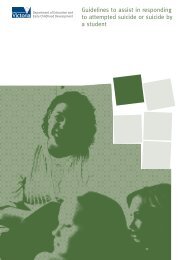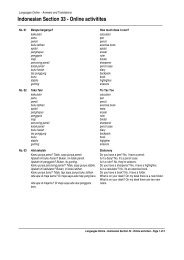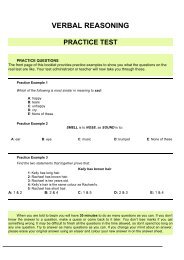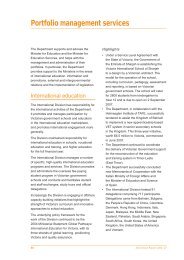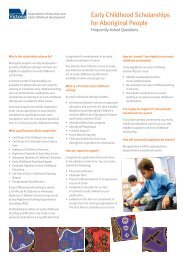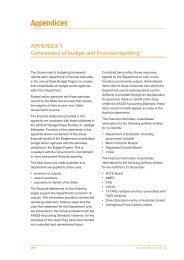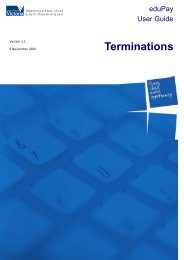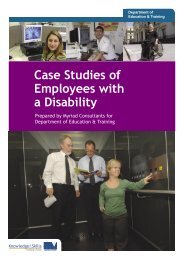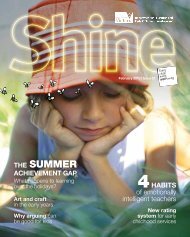November 2009 Vol. 1, Issue 10 (PDF - 16.2Mb) - Department of ...
November 2009 Vol. 1, Issue 10 (PDF - 16.2Mb) - Department of ...
November 2009 Vol. 1, Issue 10 (PDF - 16.2Mb) - Department of ...
You also want an ePaper? Increase the reach of your titles
YUMPU automatically turns print PDFs into web optimized ePapers that Google loves.
By the blazing Somers firelight<br />
Honorary historian Eugene Zolnierczyk takes a creative look at the history <strong>of</strong> Victoria’s much-loved<br />
Somers School Camp, which celebrates its 50th anniversary this December.<br />
I’m smugly reclining on my cloud, sipping a sherbet and looking down<br />
on Earth at my finest creation. Without a GPS or Google Earth I<br />
gaze with swelled pride at the way the Children’s School Health and<br />
Recreation Camp, now called Somers School Camp, has developed<br />
since its inception.<br />
This school is my finest achievement and the Victorian Education<br />
<strong>Department</strong>’s most outstanding educational facility for children<br />
throughout Victoria. With me are three camp directors who helped<br />
shape the school: Wally Bell, Jack Carroll and Bob Edmends. In 50<br />
years there have only been two others, Brendan Davern (retired) and<br />
the current school principal, Denise Anthony. But I’m getting ahead <strong>of</strong><br />
myself. So relax, get comfortably seated and I’ll tell you my story.<br />
My name is Oliver Charles Phillips (1894–1972). I was the Chief<br />
Inspector <strong>of</strong> Primary Schools and Chairman <strong>of</strong> the Somers School<br />
Camp Committee. In September 1959 my dream <strong>of</strong> a camp for<br />
Victorian school children at Somers was realised and September <strong>2009</strong><br />
sees Somers School Camp celebrate its 50th birthday.<br />
Originally established in 1940 to house the RAAF’s No. 1 Initial<br />
Training school for pilots and crews under the Empire Training<br />
Scheme, what was then known as Lord Somers Camp was set amongst<br />
140 buildings. This was one <strong>of</strong> the first RAAF training schools in<br />
Australia and approximately 15,000 RAAF and WAAAF personnel<br />
trained there over a 50-year period. After World War 2, the facility<br />
was transferred to the Immigration <strong>Department</strong> and became a migrant<br />
holding camp for European persons displaced as a result <strong>of</strong> the war. In<br />
1959 it became Victorian Education <strong>Department</strong> property.<br />
I was President <strong>of</strong> the Somers Camp committee and after much<br />
debate, camping programs began at Somers in September 1959 and the<br />
children’s school camp was <strong>of</strong>ficially opened on the 27 <strong>November</strong> 1959,<br />
by the Victorian Governor Sir Dallas Brooks.<br />
The camp was set on 27 acres and consisted <strong>of</strong> 30 army barracks. The<br />
first camp <strong>of</strong> <strong>10</strong>0 boys and five visiting teachers was from the St Kilda<br />
Inspectorate. The normal school academic curriculum was modified<br />
with emphasis placed on outdoor activities, nature study, physical<br />
education, rope courses, art, home-crafts and boating. Camp rules and<br />
procedures helped develop a sense <strong>of</strong> community responsibility.These<br />
<strong>10</strong>-day camps cost four pound six shillings or $8.60 in today’s terms. I<br />
see that today the camp runs for nine days and costs $140 – still terrific<br />
value, considering that it includes transport from anywhere in Victoria,<br />
accommodation, activities and meals.<br />
Nowadays, buses transport the children from designated pickup<br />
points to destination and return. This system began in 2002, to ensure<br />
safety and duty <strong>of</strong> care. Prior to this scheme, many children had to be<br />
transported up to 160 kilometres by car to the railway pickup point,<br />
travel by train to Spencer Street Station then catch another train to<br />
Frankston, and then travel by bus to Somers, and then in reverse for<br />
the return trip home: quite an arduous task for young children. The<br />
children were also responsible for their own luggage for the entire<br />
journey until the school purchased a truck to collect the luggage at<br />
Spencer Street.



